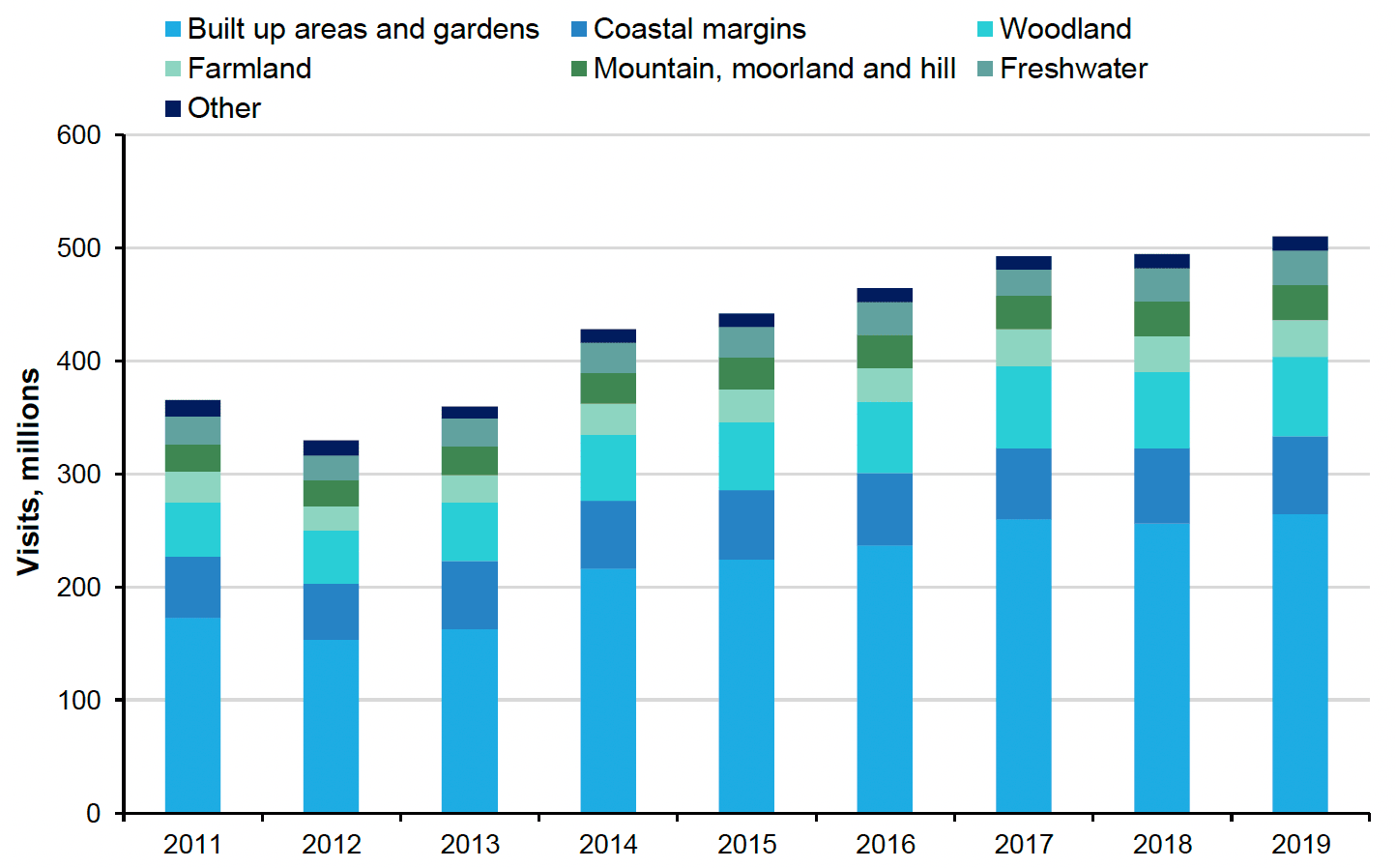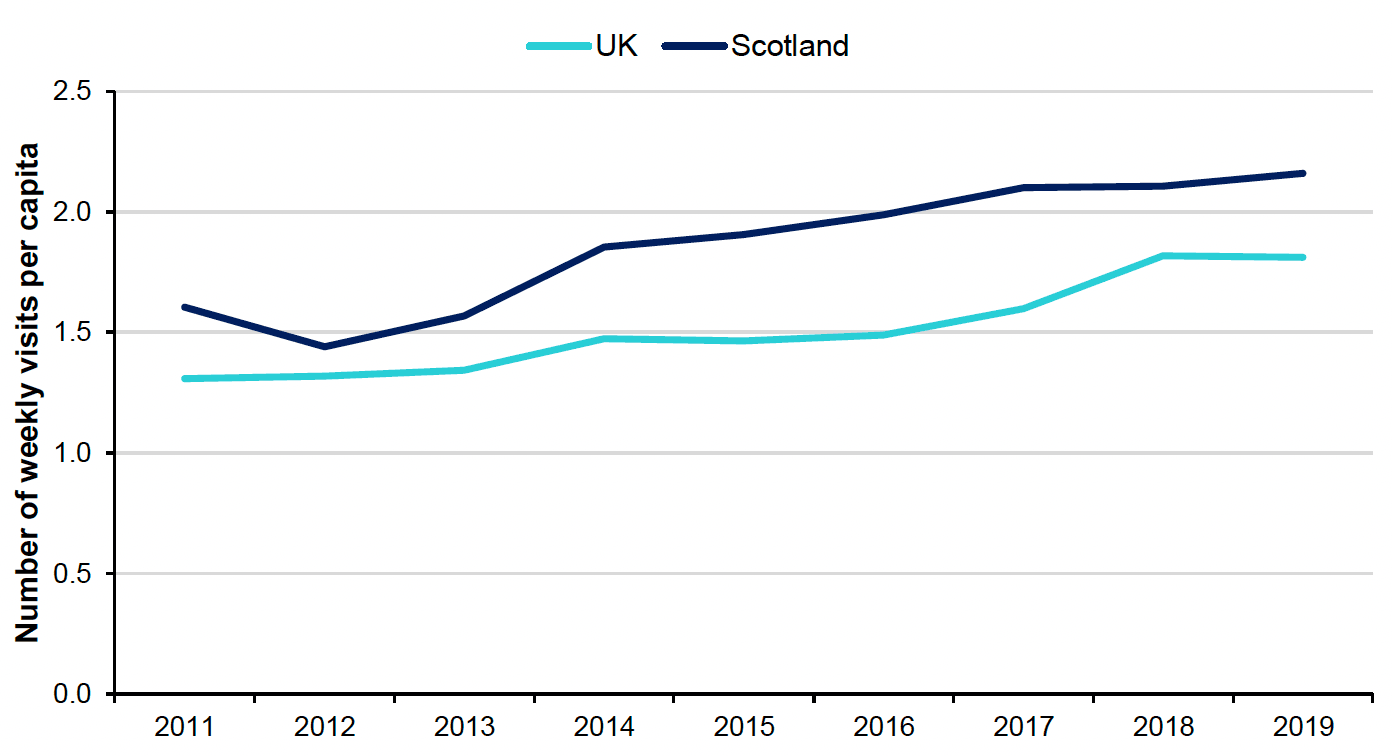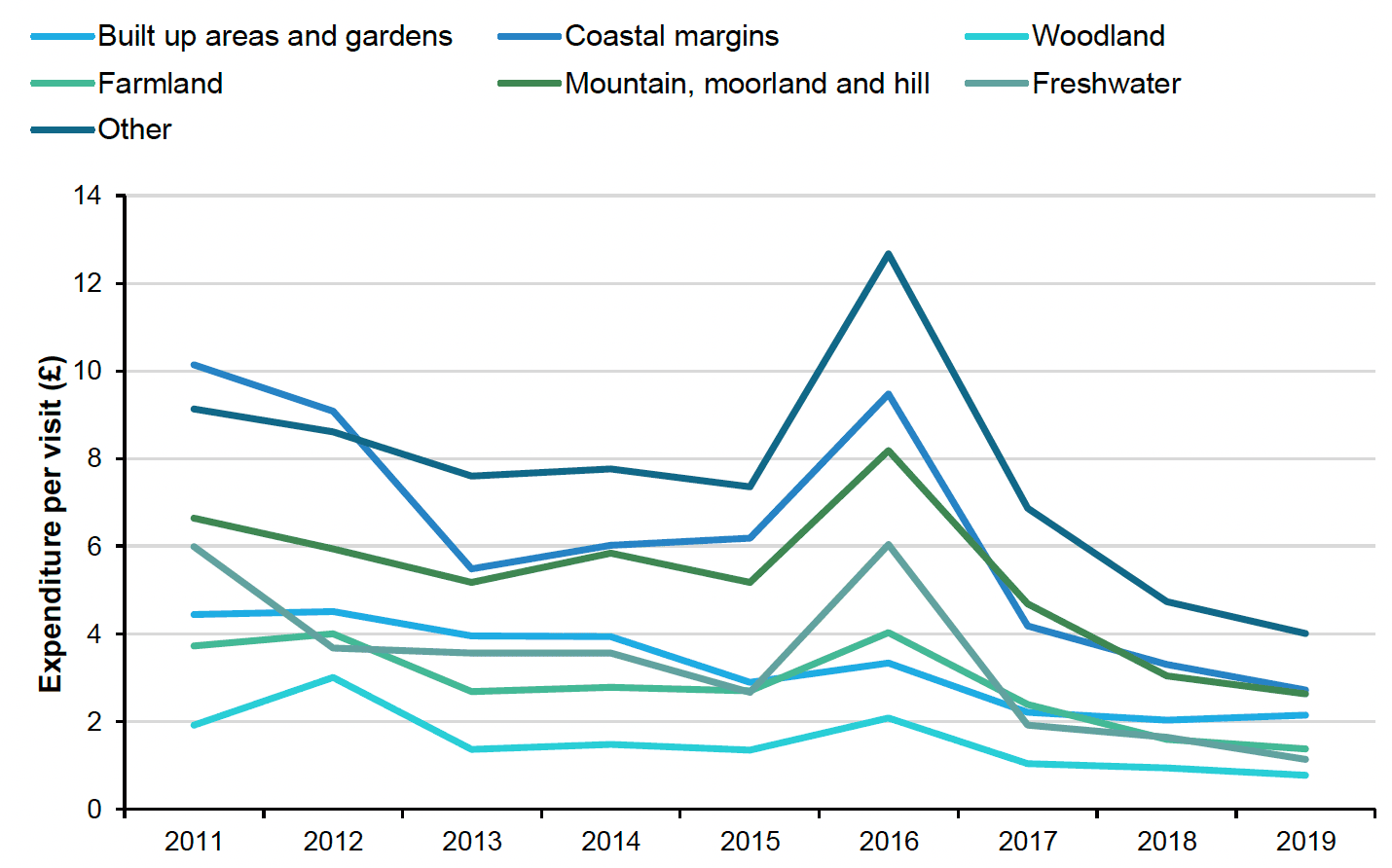Scottish Natural Capital Accounts 2022
This report estimates quantity and value of services supplied by Scotland's natural capital.
5. Cultural services
Cultural services are the non-material, experiential benefits people obtain from natural capital, such as recreation and aesthetic experience. Nature provides us with several cultural services, the value of which can be understood by measuring engagement with the natural environment.
One part of how we conceptualise this engagement with nature considers visits to green and blue spaces (such as parks and lakes), which are measured through survey responses and are presented as part of our combined recreation and tourism service.
Additionally, cultural services can be conceptualised as the desire to live near to these green or blue spaces or with a view of nature. We therefore present here the value that both features add to house prices. These two conceptualisations of cultural services provided by nature are related in that living closer to green and blue spaces enables people to make "free trips" to the natural environment.
Cultural services like recreation and tourism differ from provisioning and regulating services in that there is no one "asset" that we refer to. Whereas timber provisioning considers trees and carbon sequestration considers the benefits provided by trees for air carbon regulation, the "asset" that makes recreation and tourism services possible is the natural environment in its entirety. 'Trips to nature' therefore includes visits to all areas of nature, which can then classified into seven broad habitats.
Recreation and tourism
In line with methodological changes to the way recreation services have been estimated for the 2021 UK natural capital accounts, we now present a combined recreation and tourism account; the first time this has been used in Scottish natural accounts valuations. This method has been applied to all previous years for which data were available.
The combined recreation and tourism service valuations now use survey data to capture both shorter and longer trips taken to nature by visitors in Scotland. Previously, the recreation service was limited to using survey data that considered day trips only. By introducing tourism survey data, we can extend our coverage to include visits to nature over three hours in duration that might have been taken across multiple-day trips. For both recreation and tourism data, expenditure is taken as the amount spent on travelling to the natural environment.
The underlying tourism and recreation survey data for our estimates largely cover all years presented across the time series. However, for years where survey data were not available, we have imputed the missing data using linear forecasting methods.
During 2019, there were an estimated 510 million visits made to Scotland's natural environment. The number of yearly visits made to each Scottish habitat has increased steadily from 2012 to 2019. This has largely been driven by more visits taken to urban green spaces like local parks and gardens, which is responsible for 63% of the increase. In the same period, woodland (13%), coastal margins (11%), farmland (6%), freshwater areas (5%) and mountain, moorland and hills (5%) have all seen more modest increases in yearly recreational visits. This trend is also true for both England and Wales.
In 2019, visits to built-up urban green space areas in Scotland made up the largest proportion of visits to outdoor recreation spaces (52%). Visits to coastal margins and woodland grew by 4% and 3% on their 2018 totals, respectively. Mountain, moorland and hill areas experienced a marginal increase (0.7%) from their 2018 total, while visits to other unlisted areas fell by 2.8% from its 2018 total to constitute just 2.4% of all 2019 visits.

Source : Office for National Statistics, Monitor of Engagement with the Natural Environment (MENE) survey, Scottish Recreation Survey and Scotland's People and Nature Survey, Great Britain Day Visits Survey (GBDVS), Great Britain Tourism Survey (GBTS) and International Passenger Survey (IPS)
Scotland continues to see more weekly visits per person in 2019, 2.2 visits compared with the UK average of 1.8 visits. This is true of all years in the time series (see Figure 36). Additionally, the weekly expenditure each person makes during these trips to nature remains below the UK average; £4.32 for Scotland and £5.26 for the UK. Scotland continues to see the lowest expenditure per visit to nature (£2.00), compared with both England (£2.93) and Wales (£2.12), a trend beginning in 2018.

Source: Office for National Statistics, Monitor of Engagement with the Natural Environment (MENE) survey, Scottish Recreation Survey and Scotland's People and Nature Survey, Great Britain Day Visits Survey (GBDVS), Great Britain Tourism Survey (GBTS) and International Passenger Survey (IPS)
In 2019, UK outdoor recreation had an annual value of £14.8 billion (2020 prices). Scottish visits represented around 7% of this, estimated at £1.0 billion in 2019. This 2019 annual value of Scottish recreation has decreased by 48% from £1.9 billion in 2011, whereas the value of UK recreation grew by 2% in this same period from £14.5 billion in 2011 to £14.8 billion in 2019.
This is a surprising trend considering 39% more visits were made to Scottish habitats in 2019, compared to 2011. The decrease in annual value appears to be explained largely by people spending less money per visit to nature; in particular, making more trips at lower cost to built-up areas and gardens.
Expenditure per visit taken to all Scottish habitats has reduced by 62% across the time series, from £5.33 per visit in 2011 to £2.00 per visit in 2019. Built-up areas and gardens (-52%), coastal margins (-73%) and woodland (-59%), which are consistently the three most visited Scottish habitats, all saw at least a halving in expenditure per visit from 2011 to 2019 (see Figure 37).

Source: Office for National Statistics, Monitor of Engagement with the Natural Environment (MENE) survey, Scottish Recreation Survey and Scotland's People and Nature Survey, Great Britain Day Visits Survey (GBDVS), Great Britain Tourism Survey (GBTS) and International Passenger Survey (IPS)
Overall, visitors in Scotland reduced their weekly spending to outdoor areas by £4.23 (49%) down from £8.55 in 2011 to £4.32 in 2019, whereas the UK average fell by only £0.16 (3%), from £5.42 to £5.26, in the same period.
The asset value of recreation in Scotland in 2019 was estimated to be £57 million, 9% of the UK value.
Recreation and tourism data trends
It is important that we caveat some trends in the data presented above. This includes the sudden rise in expenditure within 2016, and overall declining trend of expenditure across the time series.
First, the data depicts a sudden rise in expenditure in 2016, followed by a dramatic fall the following year. The rise in expenditure in 2016 appears to be the result of methodological changes within the tourism-based surveys between 2015 and 2016. When responding to the survey, respondents were shown smaller lists of response options, as opposed to one single large list. In some cases, this caused an increase in the number of responses chosen by each respondent.
As data is captured at an activity level, this led to increases in the magnitude of double counting per person and therefore to a greater total expenditure across all visits. Currently, our methodology does account for double counting. However, it does not account for a fluctuation in the magnitude of double counting across the time series.
Consequently, the actual expenditure per visit appears to be multiples higher than we would expect in 2016. Unfortunately, Scotland appears to have been one of regions most affected by this technical issue. Further improvements to our tourism methodology are required to fix this issue.
Second, over the time series, while trips taken to nature have increased by 39%, expenditure has decreased. By using the travel cost method of asset valuation, accordingly, the annual and asset values have also both decreased.
This declining trend is reflected within both the recreation-based and tourism-based surveys. Therefore, we are confident that this trend reflects the reality that people are spending less today on visits to nature in Scotland than in previous years. However, examining the survey data further, this decline is exaggerated by the methodology change within our tourism data.
Other variables captured by recreation survey data, such as the average time spent travelling, car parking expenditure, vehicle running costs and transport fares expenditure all show declining per-trip values in Scotland across the time series.
Furthermore, the number of shorter duration trips has increased, while the number of longer duration trips have decreased consistently between 2011 and 2019. Similarly, the proportion of respondents travelling shorter distances per trip has increased while those reporting travelling longer distances has decreased during this time.
While it is not possible to draw any definitive conclusions from these results, individual indicators appear to point to Scottish visitors making shorter and cheaper trips closer to home, especially to built-up urban areas. This could be because of better access to nature or changing attitudes towards travelling and expenditure. While the estimates of the magnitude of this trend are not as reliable as we intend, the trend itself appears to reflect changing behaviours towards recreational activities in Scotland.
Scottish house prices: Recreation and aesthetic values
The value of green and blue spaces through house prices at the UK level have previously been published. This analysis focuses on estimating the proportions of Scottish house prices that are attributed to access or views to blue and green spaces (such as parks and lakes). Access to, and views of these spaces provide a range of benefits which are reflected through market prices for housing. By implementing a hedonic pricing method, we provide estimates for the value of green and blue spaces, relative to the value of properties within 500 meters of these spaces.
There are two important caveats to note before interpreting the estimates for Scotland. First, we were unable to include data on Scottish schools as Education Scotland only inspect a sample of schools and educational establishments are not given an overall inspection outcome in the same way that Ofsted and Estyn provide. Since there is a strong correlation between house prices and proximity to school, this lack of data will reduce the precision of the Scottish model. Unfortunately, until these data are available, we cannot incorporate these considerations into our house prices model.
Second, it is possible that our sample of urban property prices underestimate actual urban property prices in Scotland. This is because property price data from Zoopla, captures the advertised price rather than the real selling price. Scottish properties, however, are marketed with either a fixed price or "offers over" – the minimum offer accepted by the seller. As bidding for "offers over" houses can drive up the selling price of properties, our data on advertised prices likely underestimates the real selling price.
The hedonic pricing approach analyses a range of variables that affect house prices. This includes the willingness to pay for living close to green and blue spaces. Table 5 shows the variables included in this model. We can use this approach to measure the value of the "free" recreational trips to nearby green spaces, which are missing from the recreation account. The value of these "free" trips are not considered as a total volume but are assumed to be an inherent benefit of living near green and blue spaces.
It is worth noting that some of the differences that we attribute to green or blue spaces may be because of additional characteristics of the property or the local area, which the model is unable to identify.
| Characteristic vector | Component variables | Sources |
|---|---|---|
| Structural | Number of bedrooms | Zoopla |
| Property area (square feet) | ||
| Property type, such as house, bungalow, flat | ||
| Property attributes based on description (for example, garage, double glazing) | ||
| Neighbourhood | Distance to railway station | Ordnance Survey |
| Distance to local labour market | ||
| Distance to nearest transport infrastructure | ||
| Distance to nearest retail cluster | ||
| Socio-economic | Scottish Index of Multiple Deprivation, Output Area Classification | Scottish Government |
| Environmental amenities | Distance to green space | Ordnance Survey |
| Distance to blue space | ||
| Area of Natural Features in 500 metres radius of property (square metres) | ||
| Area of functional green space in 500 metres radius of property (square metres) | ||
| Area of blue space in 500 metres radius of property (square metres) | ||
| Function of green space | ||
| Area of residential garden (square metres) | ||
| Distance to railway line | ||
| View over green or blue space | Zoopla | |
| Air pollution | Department for Environment, Food and Rural Affairs | |
| Noise pollution | ||
| Distance to coast | ||
| Distance to substation, tower, overhead lines | UK National Grid |
Source: Office for National Statistics
Table 6 shows the split of the total stock value by recreational and aesthetic values for the years 2010-2016. The value of recreational services is based on the distance from green and blue spaces and the total area these spaces occupy. Distance and land cover data used in this model are taken from the Ordnance Survey. The value of aesthetic services is based on the view individuals have of green and blue spaces. Recreational values are significantly larger than aesthetic values across this time series.
In 2016, recreational asset value equalled £8.74 billion and aesthetic asset value equalled £0.85 billion. Across the time series, the average value of access and views to green and blue space has fallen by 25% from £4,450 in 2010 to £3,317 in 2016. These substantial decreases in value may be the result of many conditions. One interpretation is that people have a declining need to live next to green and blue spaces as the market tightens across the time series.
| Year | Average value (£) | Average value (%) | Stock value (£billion) | Aesthetic value (£billion) | Recreational value (£billion) | N properties (millions) |
|---|---|---|---|---|---|---|
| 2010 | 4,450 | 2.41% | 13.74 | 1.49 | 12.25 | 2.48 |
| 2011 | 3,456 | 1.92% | 10.51 | 1.28 | 9.23 | 2.49 |
| 2012 | 4,137 | 2.30% | 12.44 | 1.17 | 11.27 | 2.51 |
| 2013 | 4,046 | 2.24% | 12.02 | 1.14 | 10.88 | 2.52 |
| 2014 | 3,754 | 1.97% | 11.02 | 1.16 | 9.86 | 2.53 |
| 2015 | 3,666 | 1.90% | 10.75 | 0.99 | 9.76 | 2.55 |
| 2016 | 3,317 | 1.77% | 9.59 | 0.85 | 8.74 | 2.57 |
Source: Office for National Statistics
For annual values, we can present an equivalent rental value of living within 500 metres of green or blue space shown in Table 7. "Imputed rent" is a national accounting term for what homeowners would receive if all homes were rented. It can be thought of as the amount that non-renters are willing to pay themselves for the housing services they produce. This must be imputed as homeowners do not receive payment on their property.
| Year | Total (£ million, 2020 prices) |
|---|---|
| 2010 | 361 |
| 2011 | 294 |
| 2012 | 340 |
| 2013 | 342 |
| 2014 | 298 |
| 2015 | 292 |
| 2016 | 272 |
| 2017 | 316 |
| 2018 | 305 |
Source: Office for National Statistics
Travel to work areas (TTWA) are geographical areas created to approximate labour market areas. These are designed so that most people live and work within these defined areas, while relatively few people commute between areas. Table 8 presents the average effect of living near green and blue spaces in different TTWA.
Within the 10 most sampled travel to work areas; Edinburgh has the largest average effect with £7,195 of an average property's value being attributed to access to and views of blue and green spaces (2.93% of the average property price).
| Travel to work area | Average Value (£, 2020 prices) | Average value of property price (%) | N Validation Set | Average distance to green spaces (m) | Average distance to blue spaces (m) |
|---|---|---|---|---|---|
| Glasgow | 3,234 | 1.93% | 5911 | 276 | 334 |
| Edinburgh | 7,195 | 2.93% | 2415 | 254 | 390 |
| Motherwell and Airdrie | 2,174 | 1.65% | 1907 | 290 | 473 |
| Falkirk and Stirling | 2,454 | 1.56% | 1648 | 284 | 281 |
| Livingston | 2,660 | 1.77% | 1174 | 285 | 350 |
| Kilmarnock and Irvine | 1,952 | 1.71% | 1086 | 331 | 333 |
| Ayr | 1,688 | 1.09% | 729 | 290 | 367 |
| Dunfermline and Kirkcaldy | 2,353 | 1.73% | 601 | 315 | 355 |
| Perth | 3,162 | 1.75% | 585 | 262 | 345 |
| Inverness | 2,626 | 1.36% | 409 | 309 | 228 |
Source: Office for National Statistics
Contact
There is a problem
Thanks for your feedback